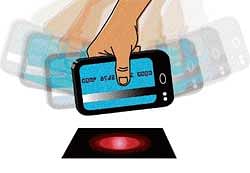Mobile wallet gains currency

He not only avoids having to fumble through his wallet and hold up the line, but the tapping also automatically adds loyalty points to his Walgreens’ loyalty card, also stored in his phone, and can help him redeem any coupon he might have downloaded from the Internet.
Soon, he will be able to do the same for his favorite sandwich at Subway. McLaughlin, chief emerging payments officer at Mastercard, has been one of the first to try out the Google Wallet mobile pay system introduced by the Internet giant in May in partnership with Citigroup and Mastercard Worldwide.
In fact, McLaughlin started tapping to pay for his coffee or his taxi ride back in 2005 with a Nokia phone, as part of a small group that was testing a new two-way wireless technology called Near Field Communication (NFC), which allows data to be exchanged between two devices at a very short distance.
NFC transforms smartphones into virtual payment cards; it has become fashionable among cellphone manufacturers, telecommunications operators and finance providers. The technology has already been successfully tested in several cities around the world, including Seoul, Nice, Oslo and Singapore. But the paucity of available NFC-enabled smartphones has hampered any major rollout.
This is changing fast. Over the summer, LG Electronics and Research In Motion, the maker of the BlackBerry, announced the release of their first NFC-enabled smartphones. That was followed by Google’s acquisition of Motorola Mobility for $12.5 billion in August, which could give Google Wallet a lift.
“Right now we’re hearing a lot of talk, mainly from Asian manufacturers, that they’re coming out with NFC-enabled phones,” said Frederick Huet, managing director of Greenwich Consulting, an international consulting firm for telecommunications and media. “You also have Apple hinting it will come out with NFC.”
Ashwin Raj, Visa’s head of mobile products for Asia Pacific, Central Europe, the Middle East and Africa, agreed.
“We are at an inflection point,” he said. “The handset manufacturers have started the ball rolling. Already terminal manufacturers are announcing their new terminals will support NFC technology. There is finally momentum for this to take off.”
Raj pointed to two other important developments – the rollout of Isis, a major US test programme for the technology, and the migration of NTT DoCoMo, the biggest mobile operator in Japan, to NFC in the coming year.
Isis is a joint venture in the United States of AT&T, Verizon Wireless and T-Mobile USA, the top three telecommunications operators, and the credit card companies Visa, MasterCard, Discover and American Express. The companies will conduct a trial in Salt Lake City, Utah, and Austin, Texas, during the first half of 2012 that should make use of NFC-enabled devices widely available in those areas.
NTT DoCoMo has been offering a Japanese “mobile phone wallet” since 2004 using the one-way contactless technology, FeliCa, developed by Sony. But it recently announced plans to make phones that support both the international standard NFC and the domestic FeliCa technology.
McLaughlin said that it was no longer a question of whether the underlying technology was working and secure – NFC is actually more secure than credit cards, he said. “If you lose your mobile, we can pull all your credentials off the phone within seconds,” he said.
“We can’t pull the data from your credit card. The data in your phone are stored in a special chip, and here it’s almost James Bond-like; if it’s ever tampered with, it self-destructs.”
To be activated before a transaction, Google Wallet requires a password to start the application, which adds another layer of security. The real question now is how NFC can be used to enrich the consumer experience, McLaughlin said.
“If it’s simply 'I can tap my phone instead of using my card,' it’s moderately more convenient,” he said. “But if we can take advantages of smartphones’ capabilities to change the information available to you, the feedback you get – that’s what’s going to be key.”
Yet, beyond the hype surrounding NFC, analysts are warning that the rate of adopting this technology could be slow. Sandy Shen, research director at Gartner, warned that the mass market adoption of NFC. payments is “at least four years away.”
“The biggest hurdle is the need to change user behavior by convincing consumers to pay with mobile phones instead of cash and cards,” she wrote in a report. A recently published report by Datamonitor, a research firm based in Britain, found that only 1.8 percent of consumers globally were likely to adopt NFC payment systems immediately; 12.2 percent were described as having a medium likelihood of using the system, while 31.7 had a low likelihood. The remaining 54.3 percent were considered “unlikely” to adopt the technology.
“The key reason why most consumers will not bite immediately on NFC is, it doesn’t actually solve any immediate need,” said Gilles Ubaghs, senior analyst for cards and payments at Datamonitor, “and in most instances is likely to involve more steps to do an act they can already do with relative ease.”
“With an NFC-enabled phone you still need to open your phone, find the app, open the app, perhaps push a few buttons and then hold it to the reader,” he said. In Japan, despite the push given by NTT DoCoMo, the use of mobile payments remains a niche market. But Ubaghs acknowledged that offering added benefits, beyond the technology, like focused discounts and offers, could be key to driving up adoption.